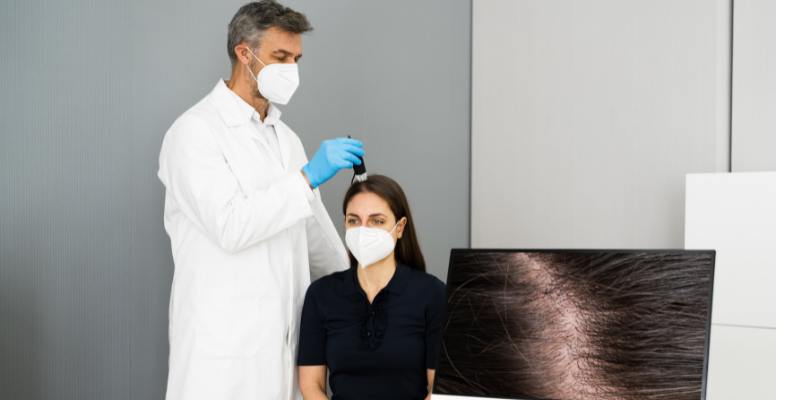Hair loss can be a devastating experience, and for some, it comes with permanent scarring.
Cicatricial Alopecia (CA) is a group of conditions that cause scalp scarring, leading to permanent hair loss in the affected areas.
While there isn't a one-size-fits-all cure, treatment options are available to manage CA and promote hair growth.

Understanding Cicatricial Alopecia
Unlike other forms of hair loss where follicles remain intact, Cicatricial Alopecia destroys hair follicles, replacing them with scar tissue.
This scarring prevents new hair from growing back. CA can affect any part of the scalp and can occur at any age. There are several types of CA, each with its own cause and characteristics.
Some common types include:
- Lichen planopilaris: This inflammatory condition causes itchy, red patches on the scalp that can scar and lead to permanent hair loss.
- Folliculitis keloidalis: This condition is characterized by small, pustule-like bumps on the scalp that turn into keloid scars after healing.
- Central centrifugal cicatricial alopecia: This type typically affects the crown of the scalp and causes progressive hair loss in a widening circle.
Diagnosing and Treating Cicatricial Alopecia
Diagnosing Cicatricial Alopecia often involves a combination of a physical examination, a scalp biopsy, and possibly blood tests to rule out underlying conditions.
Early diagnosis is crucial for maximizing treatment effectiveness.
Unfortunately, there's no cure for CA, but treatment aims to:
- Reduce inflammation: Corticosteroid creams, injections, or oral medications can help reduce inflammation and potentially slow down hair loss.
- Prevent further scarring: Antibiotics might be used to treat infections that contribute to scarring.
- Promote hair growth: Minoxidil, a topical medication, may stimulate some hair growth in non-scarred areas.
- Hair transplantation: In some cases, hair transplantation surgery can be an option to restore hair density in areas where the follicles haven't been completely destroyed.
Facing hair loss can be a significant challenge, causing emotional distress. Many individuals may not know where to turn to combat their feelings surrounding their hair loss.

However, Wig Medical is dedicated to supporting you on your journey to regaining confidence. We recognize the emotional impact that hair loss can have, and our specialized wig services go beyond simply providing a product.
The Wig Medical team comprises certified cranial prosthesis specialists who are meticulously trained to ensure a perfect fit for your wig. This translates to a natural-looking solution that empowers you to feel your best.
We boast a diverse selection of high-quality wigs, offering a variety of styles, materials, and colors to cater to your unique needs and preferences. Our team possesses the expertise to guide you through the process, maximizing your coverage potential.
Most importantly, we prioritize personalized care and support throughout your experience. We actively listen to your concerns, address your questions, and provide expert guidance every step of the way. At Wig Medical, we believe hair loss shouldn't define you.
We empower you to reclaim your confidence and rediscover your beauty. Explore our comprehensive wig selections online, schedule a complimentary consultation with a certified Cranial Prosthesis Specialist today, or contact us to learn more.
Let Wig Medical be the partner in your journey to renewed confidence. Contact a team member today to learn more about our customizable solutions.
Five Important Facts about Cicatricial Alopecia You Need to Know
1 - What is cicatricial alopecia?
Cicatricial alopecia is a group of rare disorders that destroy hair follicles, often replacing them with scar tissue, resulting in permanent hair loss.
Unlike other forms of alopecia, hair loss in cicatricial alopecia is typically irreversible due to the scarring that occurs.
2 - What causes cicatricial alopecia?
The exact cause of cicatricial alopecia is not fully understood.
It involves inflammation directed at the hair follicles, which may be caused by an autoimmune reaction, a genetic predisposition, infections, or other environmental triggers.
Several types of cicatricial alopecia are classified based on the type of inflammatory cells involved in the follicle destruction.

3 - What are the symptoms of cicatricial alopecia?
Symptoms vary depending on the type and severity but generally include gradual hair loss, scalp redness, and scaling.
Some patients may experience symptoms such as itching, pain, or a burning sensation in the affected areas.
The scalp may appear smooth and shiny where the hair follicles have been destroyed.
4 - How is cicatricial alopecia diagnosed?
Diagnosis typically involves a detailed clinical examination, scalp biopsy, and possibly blood tests to rule out other causes of hair loss.
A biopsy is crucial for confirming the presence of scarring and determining the type of inflammatory cells involved, which can help guide treatment.
5 - What treatments are available for cicatricial alopecia?
Treatment focuses on stopping the spread of scarring and inflammation.
Options may include:
- Anti-inflammatory medications: Such as corticosteroids (topical or injected), can help reduce inflammation.
- Immunosuppressants: Drugs like cyclosporine or mycophenolate mofetil may be used to control the immune system's attack on hair follicles.
- Antibiotics and antifungals: These can treat any underlying infections contributing to the inflammation.
- Direct hair restoration: In cases where the disease has stabilized, and no active inflammation is observed, hair transplantation may be an option for cosmetic improvement.
- Cranial prostheses: Medical wigs for hair loss can provide a cosmetic solution to improve the quality of life and self-confidence of those with significant hair loss.

